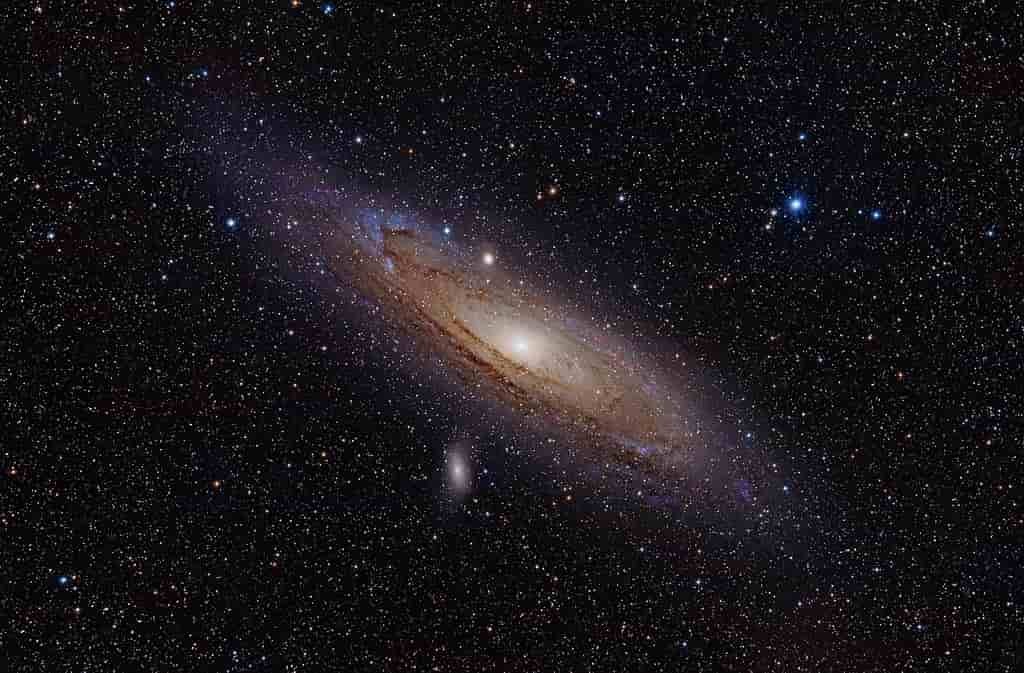Nearest Galaxy
What is the nearest galaxy? The Andromeda is the largest and the nearest galaxy and it’s about 2.5 million light years from us, in other words we see it now as it was 2.5 million years ago!
Andromeda is a sister of our Milky Way, it is like a spiral galaxy, containing some 1,000 billion stars. It is moving in our direction, at about 110 km per second, which means that a collision will occur in about… 4 billion years, plenty of time to prepare.
Read also: Planet Distance to Sun | How Far Are The Planets From The Sun?
The answer to the nearest galaxy question depends on what is meant by “galaxy”. If we consider galaxies comparable in size to the Milky Way (our galaxy), the nearest galaxy is Andromeda located about 2.5 million light years away. However, there are also a multitude of smaller galaxies, called dwarf galaxies,
Note that several dwarf galaxies, satellites of our Milky Way, are closer to us than Andromeda, such as Canis Major (25,000 light-years away), Sagittarius (80,000 light-years), or the Great and the Small Magellanic Cloud (respectively 179,000 and 210,000 light-years away).

The Andromeda galaxy in infrared light. NASA/JPL-Caltech/UCLA, Public domain, via Wikimedia Commons
Characteristics of the Andromeda galaxy
Formation
According to the results of numerical simulations carried out by the French-Chinese team using the high-performance computing resource “GENCI”, the Andromeda galaxy would have formed less than three billion years ago, at a time when Earth existed, and would have become a galaxy as a result of the collision of two galaxies.
Distance
Several independent methods for estimating extragalactic distances have been used to measure the remoteness of the Andromeda galaxy, giving fairly convergent results.
Thus, measurements of the periodicity of Cepheids in this galaxy made it possible in 2004 to determine their absolute magnitudes and therefore to infer their distance by comparison of their visual magnitudes at 770 ± 0.06 kpc (∼2.51 million from a.l.).
At the same time, the discovery of the eclipse binary which made it possible to determine with precision the size and temperature of the components – and therefore their absolute magnitudes – made it possible in the same way, by comparing their absolute magnitude with visual magnitude, to determine the distance of a galaxy at 2.52±0, 14 million al (∼773 kpc), a measurement that is very much in agreement with previous measurements by independent methods.
Astronomical coordinate systems: horizontal, equatorial, ecliptic, galactic and supergalactic
Mass and luminosity
The total mass of the Andromeda Galaxy baryonic matter + dark matter has been estimated to be around 1,230 billion solar masses, though with possible minimum and maximum values of 630 billion and 4,100 billion, respectively. The value of 1,230 billion solar masses is equivalent to less than two thirds of the Milky Way, which is estimated by this same study to be about 1,900 billion solar masses (at least 200 billion but not more than 5,500 billion). However, the uncertainty inherent in these two estimates is too great to be concluded definitively. However, we can now recall that the masses of these two galaxies are an order of magnitude equal and that the stellar density within the Andromeda galaxy is greater than that observed in our galaxy.
Rotation
Detailed spectroscopic studies have made it possible to trace the rotation curve of the Andromeda galaxy. Starting at the galactic center, the stellar speed increases to a local maximum of 225 km/s at 1,300 light-years (400 pc) then passes through a local minimum of 50 km/s at 7,000 light-years (2 kpc) before returning to a maximum of 250 km/s at 33,000 light years (10 kpc) and gradually decreases to 200 km/s at 80,000 light years (24.5 kpc).
This curve implies that the total mass of the Andromeda Galaxy grows linearly up to 45,000 light-years (13.8 kpc) from the center, then slower beyond that; the core will have a mass of 6 billion solar masses.
Sources: PinterPandai, National Aeronautics and Space Administration (NASA), Cool Cosmos, EarthSky, Royal Museums Greenwich
Photo credit: Adam Evans / Wikimedia Commons (CC BY 2.0)
Main photo description: The Andromeda Galaxy is a spiral galaxy about 2.5 million light-years away in the constellation Andromeda. The images also show Messier Objects 32 and 110, as well as NGC 206 (a cloud of bright stars in the Andromeda Galaxy) and the star Nu Andromedae. This image was taken using a hydrogen-alpha filter.



